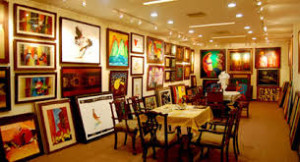Rajasthan has undergone a rapid transformation into a burgeoning cultural capital in recent decades and the city’s art scene has benefited hugely; becoming the most vibrant and exciting on the subcontinent. The city, still called Sun city by many locals, is now home to a host of independent contemporary art galleries, which feature the work of renowned and iconic Rajasthan artists as well as cutting edge contemporary figures. We look at 10 of the best of these galleries in Rajasthan.
Jaipur Gallery Art chill

Samanvai Art Gallery Jaipur
Standing tall in the heart of the ever-busy M.I. Road in the heart of the Pink City, this contemporary art gallery draws the attention of Jaipur artists and art lovers from all over India. Established in 2003, Samanvai Art Gallery boasts a large collection of contemporary Indian paintings and modern art in oil, watercolour and mixed media by renowned and promising artists from various Indian states such as Bengal, Kerala, Goa and, of course, Rajasthan. The gallery also provides a haven for artists from across the country who wish to conduct workshops and exhibitions, organised throughout the year.
Naila Art Gallery Jaipur
A meeting point for art lovers and critics, Naila Art Gallery showcases the works of several distinguished artists, which range from traditional to abstract art in various mediums and eclectic styles. Managers of the gallery and accomplished artists Thakur Dushyant Singh and Thakurani Usha Sing are among them. Located within the premises of the Naila Bagh Palace, one of Jaipur’s heritage hotels, this tranquil art space provides a stunning natural environment and welcomes artists wishing to stay and work in its peaceful ambience – in fact, the gallery aims to become a peaceful space of symbiosis for artists and their audiences.
Modern Art Gallery Jaipur
Nestled in the lush green gardens of Ram Niwas Bagh, planned by Maharaja Ram Sigh as a famine relief project in the 19th century, this small but exquisite art gallery makes a difference. The Modern Art Gallery was added to the extensive park in 1983 as a platform to promote the state’s diverse cultural events. It showcases the exclusive works of some of the most well known sculptors and modern artists of Rajasthan. Cosy but authoritative, the gallery makes for a perfect stop on a stroll around Ram Niwas Bagh.
Nidhi Art Gallery Jaipur
Spread over a large area of 4000 square feet, the Nidhi Gallery for modern and contemporary art houses a vast collection of stunning canvases, water colours and graphics by established painters, as well as promising emerging artists. The gallery has so far successfully organised 21 shows, while the latest additions to its growing collection can always be viewed in the gallery’s exhibition hall. Nidhi displays art that ranges from abstract to semi-abstract, surreal to figurative, in addition to landscapes, portraits, graphic and historical works in all mediums, surfaces and sizes. In an effort to show that art is a universal language, which cuts across borders and regions, Nidhi displays the work of both Rajasthani and pan-Indian artists.
Adroit Art Gallery Jodhpur
An artistic blend of Indian cultural heritage which incorporates Western concepts, is the defining characteristic of Adroit Art Gallery, nestled in the heart of the Cultural Capital of Rajasthan, Jodhpur. The cosy art space inspires its artists to create inventive designs and cutting-edge quality paintings. Art seems to know no bounds here, with formats and styles as diverse as traditional Rajasthani painting, figurative art, contemporary experiment and still life. Rashmi Soni, the main artist featured at Adroit Art Gallery, creates original abstract paintings, murals and replicas.
Kaman Art Gallery Jodhpur
In an effort to promote innovative artistic trends and achieve a global perspective and Indian ethos within art, Kaman Art Gallery has held several significant exhibitions over the years, featuring some of the most gifted and exceptional artists on India’s contemporary art scene. Founded by Mitendra Singh, the gallery displays original artworks as well as prints and sculptures, executed in different mediums ranging from charcoal and pastels to bronze and stone. Kaman Art space successfully ventures to popularise the vibrant and eclectic art creations of brilliant Indian artists living and working across the world.
Palette Art Gallery Jodhpur
Kamal Sharma Art Gallery Udaipur
Pristine Art Gallery Udaipur
To get more information about Agenzie di Viaggi India, Viaggio in India Su Misura and agente di viaggiare in india. visit: viaggioinindia.com